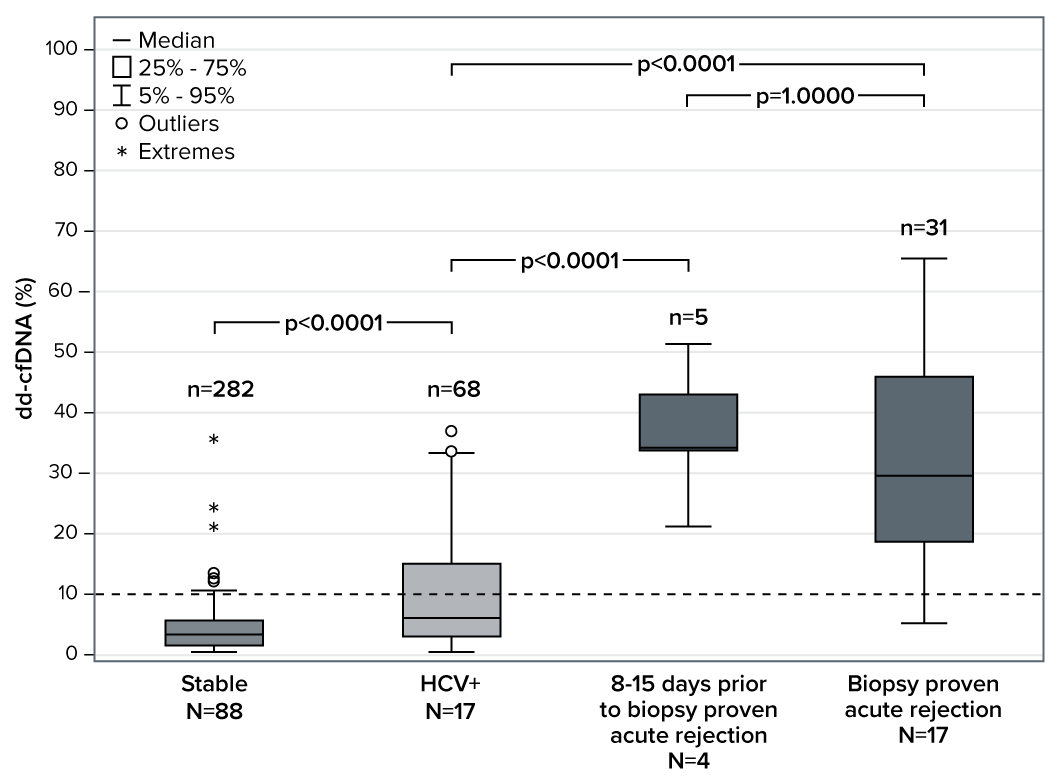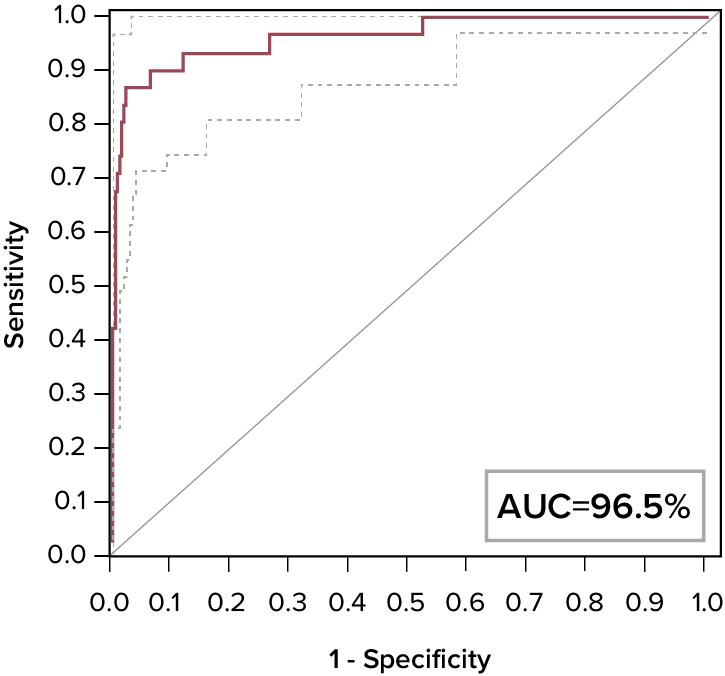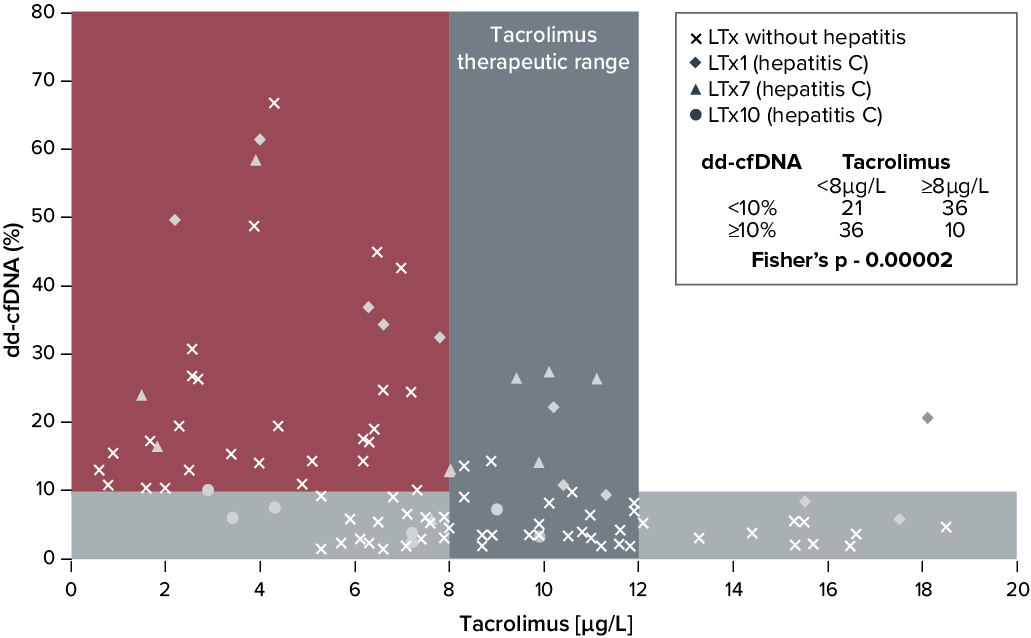
Confidently manage your liver transplant patients
Fast turnaround time. Improved outcomes.
VitaGraft LiverTM lets you know sooner to act faster
Practical. Fast. Evidence-based.
Up to 80% of liver graft biopsies show histological signs of liver graft
injury even when liver function tests (LFTs) are within the normal
range or only marginally elevated.1
Up to 40% of patients with elevated liver function tests actually experience rejection.2
With a high negative predictive value (NPV) of 97%,* VitaGraft Liver assesses graft injury with precision.3
*Calculated at a 25% prevalence.
Pioneering patient care together with clear, concise results
VitaGraft Liver
is a blood-based transplant monitoring test that quantifies the concentration of donor-derived cell-free DNA (dd-cfDNA) following liver transplantation.

- Optimized turnaround time
- Highly precise droplet-digital polymerase chain reaction (ddPCR) technology
- A personalized assay for each patient
Clarify elevated liver function test results to reduce
unneeded biopsies.3
Optimize immunosuppressive therapy to maintain
adequate immunosuppression.4
Process overview
Step 1
Post-transplant
patient blood
sample drawn

Step 2
Send samples to Oncocyte’s CAP/CLIA certified laboratory

Step 3
dd-cfDNA measured using dd-PCR

Step 4
Risk for active rejection reported

Manage the risk of transplant rejection
Bringing cell-free DNA technology to liver transplant patients
Donor-derived cfDNA is used as a biomarker to assess organ health and rejection risk status.
Through ddPCR, VitaGraft Liver determines a set of single-nucleotide polymorphisms (SNPs)
specific to each patient.5
A subset of SNPs are selected from scientifically validated commonly-shared SNPs across the global population. This allows for differentiation between the donor and recipient cfDNA. Using the selected personalized assay, dd-cfDNA is measured using absolute and relative quantification.5
With VitaGraft Liver’s strong diagnostic performance of 90% sensitivity and 93% specificity, injury can be assessed with confidence.3
Organ health and dd-cfDNA

Advantages for electing VitaGraft Liver
as your organ rejection monitoring test

Assay selection tailored to each patient’s SNPs5

May guide dosage decisions in immuno-suppressive therapy to maintain adequate immunosuppression4

Rejection may be detected before clinically suspected damage3

Accelerated turnaround time

Allows for early and real-time intervention

Avoids unnecessary invasive biopsies
See our
Clinical evidence
- Validation Data
- Assess Rejection
- Guide Immunosuppression
VitaGraft Liver patient comparison between stable,
HCV-positive, and biopsy-proven acute rejection3

Statistically significant discrimination between stable patients and those with acute rejection proven in two independent studies.3,6
- 31 samples taken from 17 patients during biopsy-proven rejection episodes3
- The percentage of dd-cfDNA was elevated substantially (median 29.6%) compared with that in 282 samples from 88 patients during stable periods (median 3.3%; p<0.001)3
- Elevated dd-cfDNA was seen 8-15 days prior to rejection confirmed by biopsy and before LFTs showed evidence of rejection during the same timepoint in five cases of rejection3
- In a multivariable logistic regression analysis, no combination of LFTs had an equal or better diagnostic value than dd-cfDNA3
N = Number of patients | n = number of samples
Receiver Operating Characteristic (ROC) curve for VitaGraft Liver3

The upper and lower limits of the 95% CI are shown as dashed lines
VitaGraft Liver has a 96.5% area under the receiver operating characteristic curve (AUCROC) 3
- All graft-derived cell-free DNA percentage values were considered (282 samples from stable periods and 31 samples during biopsy-proven acute rejection)3
VitaGraft Liver indicates under immunosuppression4

dd-cfDNA may be a good indicator for identifying adequate immunosuppression
- In a clinical study of 103 samples, there was a highly significant segregation towards patients with elevated dd-cfDNA (≥10%) and tacrolimus blood concentrations below the target concentration of 8–12mg/L4
- VitaGraft Liver may be used to optimize immuno-suppressive drug dosing for patients who have recently had a treatment change
VitaGraft resource library
Liver Clinical Summary
Oellerich M, et al. (2014)
Use of graft-derived cell-Free DNA as an organ integrity biomarker to reexamine effective tacrolimus trough concentrations after liver transplantation. Ther Drug Monit 36(2):136.
Liver Clinical Summary
Schütz E, et al. (2017)
Graft-derived cell-free DNA, a noninvasive early rejection and graft damage marker in liver transplantation: A prospective, observational, multicenter cohort study. PLoS Med 14(4):e1002286.
Liver Information Sheet
Intro to VitaGraft Liver
For hepatologists, surgeons, and clinical transplant professionals.
FAQs
Test We identify informative SNPs selected from a set of predefined SNPs. The informative SNP set for each patient is defined on the first-contact sample (selection). For all subsequent tests (monitoring), we measure the concentration of dd-cfDNA and provide a rejection risk report.
Order VitaGraft Liver for your patients following liver transplantation. Reach out to Oncocyte’s Customer Service for ordering details.

We’re here to help
Oncocyte Customer Service can answer any questions you have. Please contact us at:
Phone: 844-621-8880
[email protected]
We do not want cost to be a barrier for testing, patients can call (844-621-8880) or fax (844-584-3467) to see if they qualify for our financial assistance program.
References
1. Höfer A, Jonigk D, Hartleben B, et al. (2020). Non-invasive screening for subclinical liver graft injury in adults via donor-specific anti-HLA antibodies. Sci Rep 10(1):14242 2. Russell TA, Angarita SAK, Showen A, et al. (2017). Optimizing the Management of Abnormal Liver Function Tests after Orthotopic Liver Transplant: A Systems-Based Analysis of Health Care Utilization. Am Surg 83(10):1152 3. Schütz E, Fischer A, Beck J, et al. (2017). Graft-derived cell-free DNA, a noninvasive early rejection and graft damage marker in liver transplantation: A prospective, observational, multicenter cohort study. PLoS Med 14(4):e1002286. 4. Oellerich M, Schütz E, Kanzow P, et al. (2014). Use of graft-derived cell-free DNA as an organ integrity biomarker to reexamine effective tacrolimus trough concentrations after liver transplantation. Ther Drug Monit 36(2):136 5. Beck J, Bierau S, Balzer S, et al. (2013). Digital droplet PCR for rapid quantification of donor DNA in the circulation of transplant recipients as a potential universal biomarker of graft injury. Clin Chem 59(12):1732 6. Baumann AK, Beck J, Kirchner T, et al. (2022). Elevated fractional donor-derived cell-free DNA during subclinical graft injury after liver transplantation. Liver Transpl 28(12):1911
The VitaGraft Liver Test has been developed and its performance characteristics determined by Oncocyte. The VitaGraft Liver Test has not been cleared or approved by the US Food and Drug Administration (FDA). Oncocyte’s laboratory offering the VitaGraft Liver Test is CAP-accredited and CLIA-certified. ©2023 Oncocyte, Inc. All Rights Reserved.
